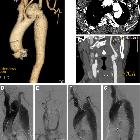Carotid web





Carotid webs, also known as carotid intimal variant fibromuscular dysplasia, are rare vascular pathologies of the internal carotid artery that are an important cause of cryptogenic and recurrent ischemic stroke.
Terminology
Carotid webs have had many different names in the literature, including carotid weblike formations or septums, carotid pseudovalvular folds, carotid shelves, carotid diaphragms, and thrombotic carotid megabulbs . 'Carotid web' is the most widely used description .
Epidemiology
Carotid webs are thought to be very rare, with two case series finding only 1.0-1.2% of patients who underwent CT angiogram for suspected ischemic stroke had radiographic evidence of carotid web . A retrospective study in 2018 has shown a prevalence of 2.5% in patients with acute ischemic stroke due to large vessel occlusion . It is more commonly found in females .
Clinical presentation
Carotid webs clinically manifest as either recurrent ischemic stroke or recurrent transient ischemic attack , especially in young patients, with one study finding that recurrence rate of ischemic stroke was as high as 29% . They are otherwise asymptomatic .
Pathology
A carotid web is defined as a thin, linear, membrane that extends from the posterior aspect of the internal carotid artery bulb into the lumen, located just beyond the carotid bifurcation . Histologically, it is thought be a rare variant of fibromuscular dysplasia, thus it is also referred to as 'intimal variant' fibromuscular dysplasia .
Carotid webs are highly thrombogenic and may be implicated in ischemic stroke . This likely occurs due to stasis of blood and platelet activation just distal to the web, resulting in thrombus formation, which can then embolize intracranially . Indeed, one study analyzing simulated flow patterns with the use of computational fluid dynamics, showed that this hypothesis was likely, by finding that carotid webs were associated with increased total surface of recirculated blood flow and wall shear stress, both of which could be implicated in thrombogenesis .
Radiographic features
In one study, approximately one-quarter of carotid webs detected radiographically were thrombosed, and just over half of all patients had bilateral carotid webs . Importantly, other radiographic evidence of fibromuscular dysplasia is often not appreciated.
Ultrasound
Carotid webs may be detectable as echogenic lesions on routine carotid Doppler ultrasound , but this imaging modality is not considered to be as reliable as CT angiography, MR angiography or DSA . There may or may not be haemodynamically significant stenosis accompanying a carotid web .
CT
CT angiography is most commonly used to detect and evaluate carotid webs . In particular, thin axial and oblique sagittal views are most useful . Radiographically, carotid webs are typically described as shelf-like, linear, thin, smooth filling defects, located along the posterior wall of the internal carotid artery bulb, just beyond the carotid bifurcation .
MRI
Findings on MR angiography are identical and comparable to those seen in CT angiography .
DSA
Digital subtraction angiography is considered the gold-standard imaging modality for detecting carotid webs, whereby contrast is seen to pool in the web, even in venous phases . Although this classic finding may not be appreciated on standard posteroanterior or lateral DSA projections, and oblique projections may be required .
However, DSA is less accessible and more invasive than CT or MR angiography and carries inherent risks, thus is not routinely a first-line imaging investigation .
Treatment and prognosis
Given high risk of recurrent ischemic stroke, appropriate management of carotid webs is important. Management options include pharmacological therapy, such as use of antiplatelet agents, or surgical therapy, such as carotid stenting or endarterectomy . Although evidence is limited to a few case series, one study found that rates of ischemic stroke were lower in patients given surgical therapy when compared to a group given only pharmacological therapy .
A recent survey of current management practices for carotid webs showed that antiplatelet therapy was the most common treatment for patients with either asymptomatic webs or presenting with a first episode of acute ischemic stroke. Endarterectomy or stenting was the preferred management for multiple or recurrent strokes .
History and etymology
The first description was in 1968 by Rainer et al. , although the term 'web' was first used in 1973 by Momose and New .
Differential diagnosis
- spontaneous internal carotid artery dissection flap
- dissection is generally more distal along the internal carotid artery, has more irregular borders, and may cause increase in the arterial diameter from pseudoaneurysm
- atherosclerotic plaque
- tends to have more irregular borders, may also be distal to the internal carotid bulb, and may have associated calcifications
See also
Siehe auch:

 Assoziationen und Differentialdiagnosen zu intimale Variante der fibromuskulären Dysplasie der Arteria carotis interna:
Assoziationen und Differentialdiagnosen zu intimale Variante der fibromuskulären Dysplasie der Arteria carotis interna:


